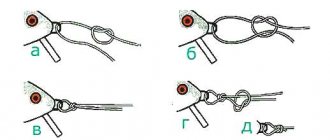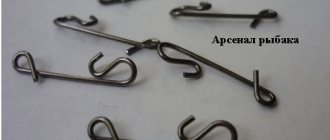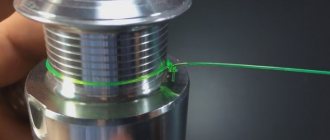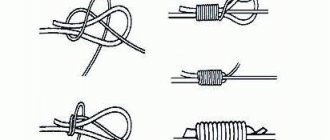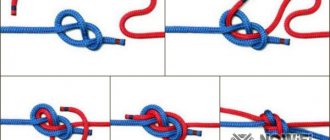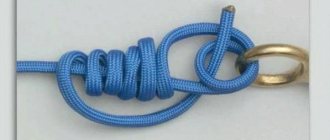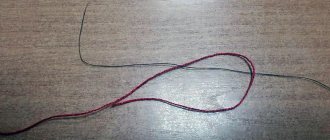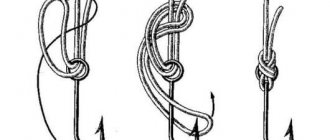Ropes of equal thickness
Tourist knots with names (diagrams and descriptions of how to knit from ropes of equal diameter are discussed below) help tourists on a hike. If it is necessary to tie 2 cords of the same thickness, tourists use special types of cords created on the basis of sea knots.
Straight knot
The straight knot is called the Hercules (Hercules) knot. Since ancient times, it has been used when it is necessary to connect a broken rope, lengthen a cable, or pack a light load.
Technique:
- They take a rope in each hand.
- The ends of the right and left ropes are intertwined once.
- An open loop is formed from the free end of the top rope.
- The end of the bottom rope is pulled into this loop, repeating the bottom weave in a mirror image. The result is a symmetrical bunch of 2 loops.
- The knot is straightened and tightened by pulling the ropes in different directions.
In a regular straight knot, the short ends are parallel to the long ones and are opposite each other. If they stick out in different directions, the connection is made incorrectly and will come undone under load.
Direct Node Properties
| Positive | Negative | Features of use |
| Easy execution | It contracts strongly when loaded and wet. | A stick or carabiner is inserted into the knot to make it easier to untie, except in situations where it is important to maintain tension in the rope or the knot needs to be pulled through another carabiner. |
| Dissolves quickly if necessary | Cannot be used on wet, icy or synthetic ropes. | Control nodes required. |
| Crawls under heavy loads. | Not used in mountaineering or in belay connections. |
The main requirement for a knot is to use ropes of the same thickness and perform it correctly , otherwise it will unravel on its own. Sailors know that incorrectly tying the Hercules knot has more than once led to human casualties.
Reef
In situations where you need to tie something tightly and then quickly untie it, use a reef knot. Sailors tie lifeboat covers, sails, and deck machinery together in this way. In tourism, a reef knot is used to connect auxiliary ropes that are subject to variable loads. The popular name for the connection is a knot with 1 bow.
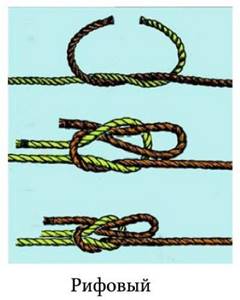
Technique:
- Tie a lower half-knot and make a loop similar to the loop of a straight knot.
- The end of the other rope is folded in half and threaded into this loop, tightened.
- The result was half a bow. The short ends of the cord should extend to one side and be parallel to each other and to the long part of one of the ropes.
The cords for the reef knot are non-synthetic, of the same diameter and made of the same material. A knot with 2 half-bows is called a double reef knot and is used in everyday life for wrapping packages, tying laces and bows.
Counter
The second name for the oncoming conductor is a ribbon node. Climbers and hikers use it to tie slings and belts. Refers to auxiliary connections, takes a long time to tie. Serves for connecting tapes of the same and different diameters, for tying rope to tape. The counter knot is reliable, does not slip and holds weight well.
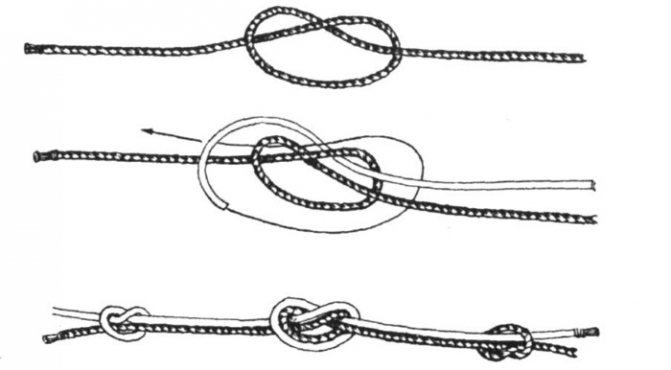
Counter knot: tourist knots (names, patterns, how to knit)
Technique:
- The free ends of the ropes are placed towards each other.
- The end of one rope is tied with a simple knot and is not pulled together.
- The second rope is pulled into the knot, moving parallel to the bends of the first rope and avoiding distortions.
- The ligament is tightened as tightly as possible.
On slings, control knots are not knitted; in other cases, the connection is strengthened. The disadvantage of an oncoming knot is the ability to become so tight under heavy load that it is impossible to untie it.
Weaving
A strong knot, other names: fishing, forest, river. The tourist name is auxiliary bowline. The weaving knot must be reinforced with control knots.
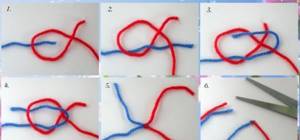
Weaving knot: tourist knots (names, patterns, how to knit)
Technique:
- The free end of one cord is tied with a simple knot and the second cord is pulled through it.
- Grab the first cord with the end of the second cord and tie a regular knot.
- The 2 resulting knots are shifted and pulled together. Control knots are made at the free ends of the ropes.
The advantage of the weaving knot is simple tying. Its disadvantages include the ability to slip and tighten strongly under increased loads. Fishermen use a knot to tie fishing lines.
What is a brass knot?
The name of the bundle comes from the sheet - 310 in the order of the gear that controls the sail. A simple clew was created to securely fasten two ropes together, able to withstand the extreme tension when the sail is filled with wind (Figure 1).
Its advantage was not only greater resistance to any tension, but also the ability to fasten ropes of different diameters. This is how the top rope was included in the list of only two existing connections (besides it, only the academic one was developed), providing for the possibility of using ropes of different cross-sectional diameters.
Advantages of the node
Bramsheet weaving is distinguished by the versatility of its use - it is suitable for any activity that involves handling threads or ropes. This list complements the knitting of tourist knots of the bramlock type, which are applicable for any area of outdoor activities.
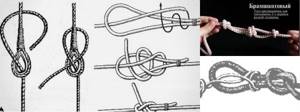
Figure 1. This is what a rope connection looks like
The main advantage is the relative ease of twisting combined with the short duration of the manufacturing process itself. Having two ropes on hand or one rope torn in two, you can join the ends in a few precise movements.
The equipment is reliable and durable, and with proper skill, the winding of the front window can be done in up to 30 seconds. However, the question remains open: what is the broader purpose of the knot, what application will the windlass ligament find in everyday life, and how to master this technique the first time.
Application area
As we mentioned above, the main industry in which the windlass knot will be used is outdoor activities or emergency situations that require a reliable and long rope (Figure 2).
Modern yachting and mountaineering, road trips, construction (external façade decoration), critical situations - whenever it is necessary to tie two ends of ropes of different diameters - the brass pole comes to the rescue.

Figure 2. The scope of application of the connection is extensive: mountaineering, maritime affairs and tourism
In tourism, the topsheet knot plays a fundamental role: in building a tent camp, braiding logs for a raft, creating a handmade sail, fastening fishing gear, creating a reliable climbing rope that can withstand heavy loads, as well as repairing clothes and shoes.
Ropes of different thicknesses
Tourist knots with names, diagrams of which help tourists connect ropes of different diameters, are used depending on the situation.
Shkotovy
The knot got its name from the sheet - the gear with which the sail is controlled. Other names for the ligament are Weber's knot, weaving bowline, net, bucket. In this way, a tensioned rope is tied to a carabiner or metal ring. The knot is used if the rope is under constant tension. Under light or variable loads, the clew slips.
Technique:
- At the end of the thicker rope, a closed loop is tied, with the short end passing on top of the long part.
- Thread a second rope into the loop and pull it out, wrapping the loop in a circle at the base.
- The short end is crossed with the long end of the rope and pulled through the loop. It turns out that a thin twine goes around the base of the loop in a figure eight.
- The knot is tightened and a safety net must be tied.
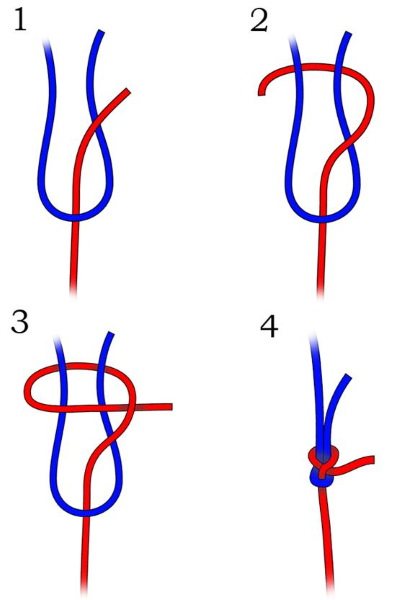
Traditionally, ropes of different thicknesses are tied with a clew knot, but it also firmly holds ropes of the same diameter. Under load, it does not tighten or weaken the rope, and is easily untied. This knot is not used for synthetic cables due to possible slipping.
Brass clew
A reinforced version of the Weber knot, another name is a double clew. It is used for rigging work, tugboats, when you need to connect to a rigid cable. The main clew assembly is used under constant load; it can withstand jerks and sudden changes in direction of movement.
Technique:
- A closed loop is made from thick rope.
- The end of the second rope is pulled into it, the base of the loop is circled with it, and a thin rope is threaded under itself over the loop.
- Once again, go around the base of the loop with the free end and pull it into the passage between the loop and the thin rope.
- The knot is tightened, holding the thick loop, and straightened. Control knots are tied on both sides.
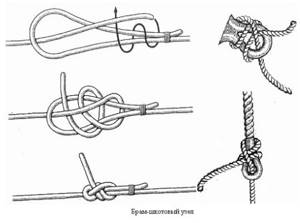
The clew assembly reliably holds both ropes of different diameters and rigid artificial cables of the same thickness.
Academic
Tourist and maritime knots, different in purpose and knitting, received the same name - academic. Diagrams and descriptions will help you distinguish them and apply them correctly.
The maritime academic knot is effective when you need to tie tense rigid cables or connect an elastic rope with a rope. It is used for tying bulky and elastic loads. The knot is simple, does not slip, and is easy to untie.
Technique:
- The ends of 2 ropes are placed one on top of the other and intertwined once at a time, pulled upward.
- The weave is repeated, only the rope is twisted in the other direction, towards the turns of the first half-knot.
- Tighten the ends of the ropes. The result was a knot in the form of a pigtail.
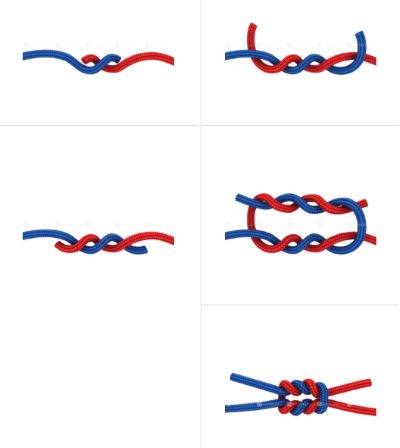
The academic maritime knot connects simple and synthetic cables. Fishermen use it to tie fishing lines.
A more complicated version of the direct knot is the academic tourist knot. When loaded, it tightens less and unravels more easily than a straight one. The unit is effective under constant and variable impact.
Technique:
- A half-loop is formed from a thicker cord.
- The free end of the smaller cord is threaded into a loop, the base is twisted, and the short and long ends of the cord are crossed.
- Pull the short tail of the cord into the loop, tighten it, and secure it with safety knots.
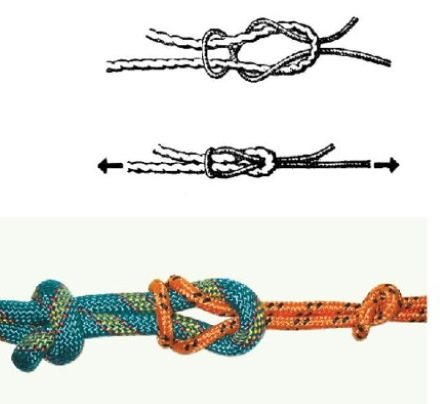
This knot is used to tie a rope to a pole or tree.
It is prohibited to use the academic tourist hub during suspended crossings.
Node classification
Ropes, cords, ropes, fishing lines - these products are widely used for various purposes. But their main purpose is to tie something or attach it to things. Without loops and knots, these actions cannot be performed. Tying techniques differ. There are ancient methods and modern ways to connect the ends of ropes or create a loop. You shouldn’t tie a beautiful ribbon on a gift and moor a boat in the same way. Connections are created from one or more ropes. Their main difference lies in the scope of application.
Thus, depending on the area of use, they distinguish between marine, tourist, mountaineering and other units. In each direction there are hundreds of ways to tie them. The connections also differ in the requirements put forward to them. For example, climbing ties should have the following properties:
- be easy to remember
- easy to knit,
- withstand significant loads,
- untie without effort (except when knitting a tightening type).
You can learn how to tie a strong knot with practice. You don't need to memorize all the methods. It is enough to learn how to tie the chosen options and improve your skills with different ropes.
Additional knots and loops
Tourist knots with names (diagrams show rope safety and auxiliary connections) are used during descents, ascents, and crossings. In this case, tourists use modifications of sea knots.
Conductor
The conductor is a non-tightening loop knot, simple, tied with one hand. It is done at the beginning or middle of the cable for fixation. Under the influence, the knot is tightly tightened and does not slip.
A conductor is used to connect a rope to a carabiner or a metal ring and tie it around a tree or pole. The knot is used in safety systems to secure rope ladders. If there is a damaged section on the cable, it is isolated by tying off the conductor.

Technique:
- The end of the rope is folded in half to form a loop.
- Pull the double end into the loop and tighten.
- If the fastening is used under variable loads, then a control knot is knitted.
The disadvantage of the conductor is that it is difficult to unravel; it works worse in the middle of the cable than at the end.
Dummy knot
An additional knot that is used to tighten the top of a bag or backpack. The pacifier can be easily untied by pulling the ends of the rope in different directions.
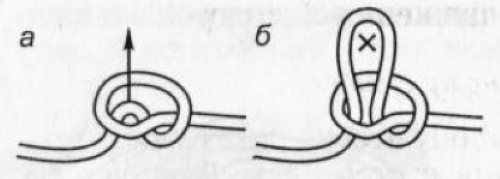
Dummy: tourist knots (names, patterns, how to knit)
Technique:
- Make a loop in the middle of the rope.
- One part of the rope is pulled through it, forming an eyelet loop.
- Tighten the knot.
The dummy bundle is used when tying bowline and double conductor knots.
Marking unit
Another name for the marking unit is Alpine coil. This is how wires and ropes up to 40 m long are tied when they are rolled into a coil for transportation and storage - a multi-layer ring. The bundle secures the edge of the cable and prevents the skein from unraveling.
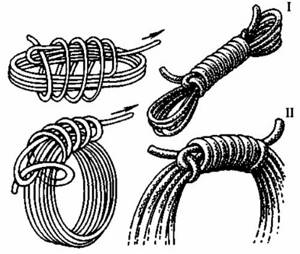
Marking knot: tourist knots (names, patterns, how to knit)
Technique:
- Roll the rope into a coil, making the last turn 1/3 shorter than the others.
- A loop is formed at the end of the rope.
- Wrap the skein and loop in tight turns with the free end of the rope 5-7 times and pull it into the loop.
- Tighten the knot until it stops.
Tourists use marking fasteners when making stretchers to build up short wooden parts of the base. Signalmen using an alpine reel restore a damaged cable.
Bachmann knot
The grasping knot is named after its creator, mountaineer and rescuer Franz Bachmann. Under load, the ligament presses the carabiner to the cable, preventing it from moving. The Brahman knot is used for rescue work, lifting loads, suspended crossings, and is knitted on single and double ropes.

Technique:
- A rope of less thickness is threaded into the carabiner and its long base is applied to the leading cable.
- A rope, folded in half, is passed into a carabiner and screwed to the cable with 3-4 turns.
- Under the influence of force, the knot presses the carabiner, preventing it from moving. To resume movement of the carbine, the load is released.
The Bachmann knot is reliable, does not tighten, and can be operated with gloves. Disadvantages of fastening - it does not hold an icy rope well, it can slip, for this reason it is practically not used in belay systems.
Austrian conductor
The Austrian conductor refers to non-tightening knots, other names are the middle conductor, the riding loop, the Alpine bloodworm. It is used to create a reliable loop in climbing ropes, rope ladders , in fishing and in everyday life. The knot is easy to untie, does not slip, and slightly reduces the strength of the rope.
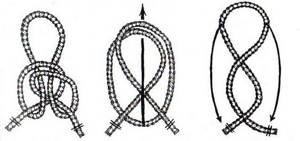
Austrian guide: tourist knots (names, patterns, how to knit)
Technique:
- Fold the rope in half in a loop and cross it again to make a figure eight.
- The upper loop is lowered down, brought under the intersection of the rope and pulled into the lower part of the figure eight.
- The loop is corrected and the knot is tightened in both directions.
Performing a median conduction requires practice and is awkward to perform with mittens and one hand. At the end of the rope, experienced tourists recommend tying not an Austrian knot, but a figure eight loop.
Stirrup
A stirrup, also known as a dandy or a bleached one, is a knot that is used to attach ropes to supports, carabiners and other objects with a flat surface. It is used for self-insurance, during rescue operations , and used as a leg loop during lifting. Using a stirrup knot, several objects are tied together with one rope.
Technique for performing on a support:
- Wrap the free end of the rope around the post once, form a loop and lower the end down.
- At the bottom, screw another loop onto the support and tighten it.

If the rope is synthetic, then an additional knot is tied close to the support. When tying the stirrup at one end, a control knot is also necessary.
One-end technique:
- Pass the rope through a support or carabiner.
- Cross the ropes to form a loop and make another loop towards the first.
- Place the second loop on the support (carabiner). Tighten the stirrup by simultaneously pulling down the two ends of the rope.
When using a stirrup, you need to take into account that with a constant load the knot does not tighten, but with a variable application of force it creeps.
Grasping knot (Prusik)
The knot was invented by the Austrian mountaineer Karl Prusik. It is tied with a thin rope (rep cord) on the main rope of a larger diameter. The optimal ratio of rope diameters is 1:2.
Prusik is used in the manufacture of tension crossings, for insurance during ascent and descent along a rope. The knot is simply knitted with one hand, firmly holds the load, and moves easily when loosened.

Grasping knot (Prusik): tourist knots (names, patterns, how to knit)
Technique:
- The ends of the cord are tied together to form a loop.
- Wrap the main rope in a loop and pull it through yourself. This is repeated so that symmetrical turns are formed on the sides of the fastening. Climbers use a knot twisted in 3 turns.
- The prusik is adjusted and tightened. If the cord was not tied with a counter knot, then check it.
Disadvantages of the knot: it slips on wet and icy surfaces, does not hold on to rigid cables, and requires a lot of tying practice.
Spanish gazebo
The Spanish arbor (boatswain's) knot looks like 2 connected loops. The bundle serves as an alternative to a rope cradle during rescue operations. To help the victim, his legs are inserted into 2 non-tightening loops of the knot, a rope is tied halfway at chest level and the person is raised or lowered.
Technique:
- In the middle of the rope, fold 1 large loop, and on 2 sides of it - 1 smaller loop.
- The large loop is folded forward and 2 side loops are pulled into it.
- The knot is tightened tightly.
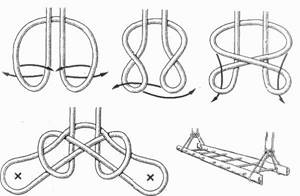
In the navy, with the help of a Spanish bowline, they build a gazebo for external work. A board is inserted into the hinges of the assembly, on which the sailor sits, and he is lowered overboard or lifted onto the mast for painting.
Eight
The figure eight knot is a locking knot that is quick to perform. It thickens the rope and blocks it, preventing it from slipping through fastenings or holes. Using a figure eight, climbers attach carabiners to the cable, and fishermen tie hooks to the fishing line.
The knot does not untie itself, does not move, and does not tighten. It is used on cables and ropes made of all materials. The figure eight is not suitable only for rigid fluorocarbon lines.
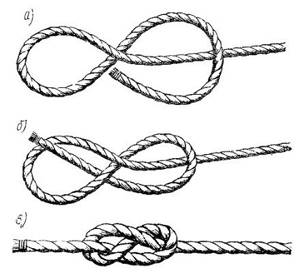
Figure Eight: tourist knots (names, patterns, how to knit)
Technique:
- The rope is crossed in the form of a loop so that the long part of the rope is on top of the short one.
- Pull the short end into the loop.
- The knot is tightened.
Other names for the ligament are Savoy and Flemish knots. Based on the figure eight, at least 20 units have been developed, different in purpose. A popular fastening option is a figure eight loop. To obtain it, the free end of the rope is folded in half and a knot is tied according to the traditional pattern.
How to knit a net with a clew knot
The most famous weaving method is the pearl net. It is easy to implement, since only light nodes are used. In this case, the size of the cells will depend on the width of the shelf used.
Net weaving:
- First you need to make the main loop and secure it to the work surface with a pin. The circle should be large and at least twice the thickness of all nodules.
- Next, you need to thread the shuttle and secure the working thread to the bottom of the loop using a clew knot.
- A shelf is placed under the knot and the working thread is placed on it.
- Next, the working thread is pulled down behind the shelf and passed through the base loop from the wrong side to the front side. After this, the shuttle must be pulled down and the shelf pressed tightly against the clew. At the same time, hold the working thread with your thumb and forefinger in the place where it intersects with the warp.
- After this, it is necessary to make a second clew knot and tighten it on the upper edge of the main loop.
- The work continues in the same way. In this case, it is not the knots that need to be counted, but the resulting loops.
- When starting the second row, the shelf is removed, and the entire work is turned over to the other side so that the last loop completed is on the left. The shelf is placed under the loops of the first row and wrapped around it with a working thread, directing it downwards.
- Then the second row is woven, tying each of the loops of the previous row with a clew knot. All subsequent rows are performed in the same way, turning their work at the end of each row (you should always move from left to right).
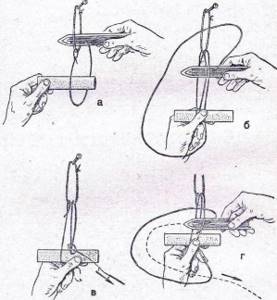
The clew knot is simple to make and easy to untie, but it lives up to its name - it holds the clew tightly, while being tightly tightened, without damaging the cable.
For children
Games with knots develop the child’s imagination, fine motor skills and perseverance.
Cords for activities with preschoolers should be multi-colored, about 50 cm long, of medium thickness and not rigid. You can make a stand according to the child’s height, on which you can attach all kinds of ropes. First of all, the baby is taught to tie shoelaces, bows and ties for dolls, and decorative ties on clothes.
Begin training with a simple knot, which is tied with one hand:
- Step back 3 cm from the thumb and hang a rope on the hand so that the back part is shorter than the front and does not exceed 30 cm.
- Swing the hand with the rope from right to left and try to catch the back end of the cord.
- A loop will be formed in the palm of your hand, and the short end of the rope will be held between your index and middle fingers.
- With a sharp movement, shake the rope from your hand, while firmly holding its end with your fingers and trying to pull it into the loop. It takes a preschooler several attempts to learn how to tie a simple knot this way.
The conductor and straight knot are mastered next, then more complex ligaments. It is important for a child to see the benefits of the acquired skills, so you need to involve him in tying ropes at home and on vacation, and ask for help in setting up a tent or canopy.
How to learn to tie knots correctly?
There are two ways to learn how to tie sea knots: algorithmic and visual. During the first method, the student memorizes the sequence and step-by-step movement of the rope. This usually happens in classes with a teacher in maritime institutions or tourism sections. The teacher shows the tying sequence, and the student repeats after him.

The second method is based on visual memory, when performing and memorizing tying methods using diagrams, pictures, and training stands. The student sees the end result and tries to make his node look the same as in the diagram.
How to secure a rope to a base
Tourist knots with names (every tourist needs to study diagrams of how to knit a rope on a support) are studied before going on a trip. Such bundles are used for ascent and descent, construction of a canopy, and during rescue operations.
Bayonet
The non-tightening knot consists of 2 half-joint parts. This is a simple and reliable knot for securing something on a vertical base and under tension. This is how a rope is tied to a hook for towing a car or boat. The bayonet knot is used to create crossings, rope ladders, stretching awnings, and securing loads.
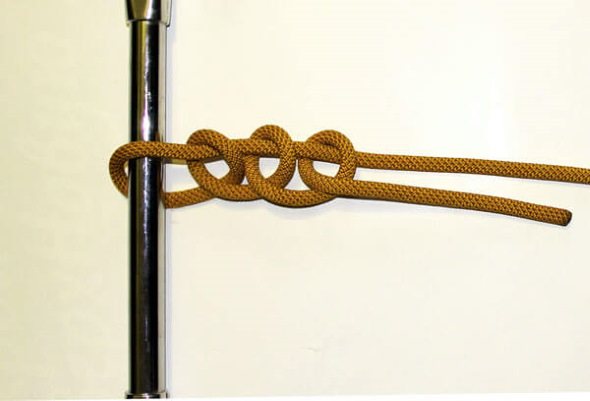
Bayonet: tourist knots (names, patterns, how to knit)
Technique:
- The rope is thrown over the support and a loop is formed.
- Pull the end of the rope through the loop - this is the first half-bayonet.
- Using the short end of the rope, make a loop at the long end and repeat the half-bayonet. It is knitted in the same direction as the first one. If you tie the second part of the bayonet incorrectly, it will tighten.
- The free end of the rope must be secured with a control knot.
The maximum number of half bayonets in a knot is 3. It is not recommended to knit a larger number, as this will not increase the strength of the bayonet, but will increase the time for tying and unraveling it.
Bowline loop
A bowline knot is a loose loop at the end of a rope. Sailors consider it the king of knots for its reliability. The bowline unravels quickly and can be tied with one hand, which is important during rescue operations. This knot is used to attach the cable to metal rings, hooks, vertical and horizontal supports.
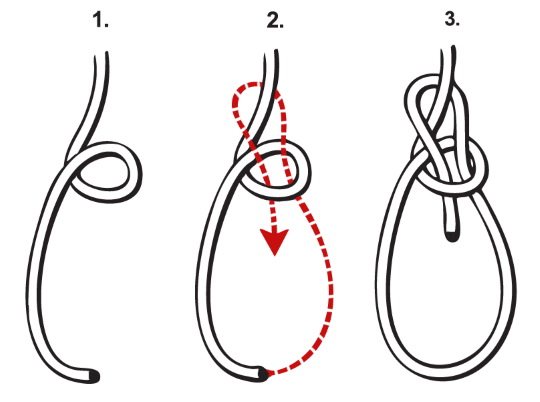
Bowline: tourist knots (names, patterns, how to knit)
Technique:
- Make a simple loop at the end of the rope or wrap the support once.
- Use your fingers to hold the crossing point and pull the free end of the rope into the loop from below.
- Stretch the rope, go around the long part from behind and again pass the end into the small loop.
- Tighten the knot by pulling the large loop and the long part of the rope in different directions.
The bowline must be secured with a control knot. The disadvantages of the royal knot are the difficulty of tying and the ability to slip under unstable loads.
Noose
A practical knot for securing the cable to the base is the Zimmerman noose. It belongs to simple bundles, is easy to knit and unravels quickly without load.
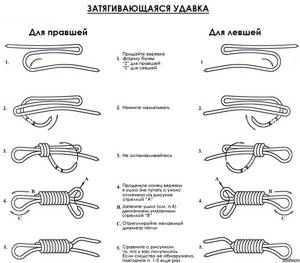
Noose: tourist knots (names, patterns, how to knit)
Technique:
- The rope goes around the support and forms a closed loop.
- Continue moving the rope along the loop, twisting 3-4 turns around it.
- Pass the end of the rope through the loop and pull it up.
The Zimmerman noose reliably holds tension under constant load, and slips under variable load. To prevent this from happening, the knot is fixed with 1 or 2 control knots.
Reliable and strong
In the sailing fleet, one of the most reliable and strong knots is considered to be the topsheet knot (otherwise known as topsheet). It is named after the top sheet gear, which is used to stretch the corners of the lower part of the straight sail when installing the top sails. It is also called double clew. The clew knot is just not that reliable. They tie only single sheets of sails from below, and the top sheet knot has a much wider application. This includes tying top sheets, boom sheets, top halyards, boom top halyards, top rope halyards.
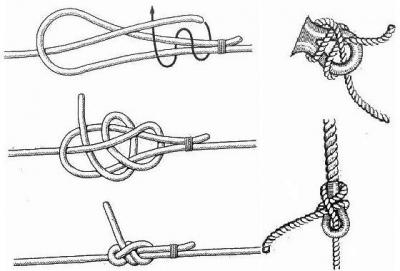
The reliability of the knot lies in the technique of tying it. The loop or krengel is wrapped around the running end of the rope not once, but passed under the root end twice. This type of knot holds cables of the same and different thicknesses equally well. They can be used to tie natural and synthetic ropes, thin and thick. Because of its convenience and reliability, it is widely used in mountaineering, because if there is no tension in the cable, it does not immediately untie, and this is important for safety at high altitudes.
Pulling the rope without sagging
A rope stretched between 2 supports sags under the influence of weather conditions and loads. There is a way to maintain tension without using special tools.
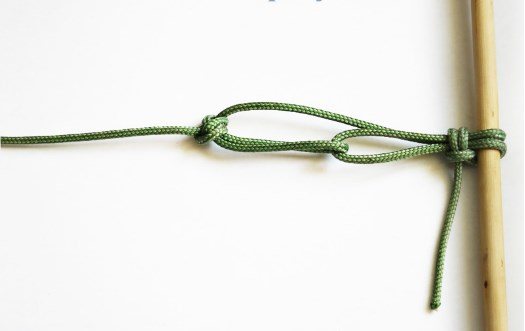
Pulling the rope without sagging
Procedure:
- A rope is tied on one support using any knot that can be quickly untied.
- Make a figure eight loop or other loop knot in the center of the rope and pull the rope through it to make a small loop.
- Go around the second support with the free end and return to the figure eight loop.
- The free end of the rope is tied to the second loop; the type of knot does not matter.
- The structure is tightened as much as possible; when finished, it looks like a rope forked from the middle.
This method of pulling a rope is suitable for simple situations - drying laundry, fish, transporting a light load across a stream. The popular name of the method is pulley, it comes from the designation of a load-lifting industrial device.
Improved rope tension
To improve the tension of a stretched rope, experienced hikers use homemade or store-bought fasteners. Lanyard is a device equipped with rings or hooks at the ends. It is used for tightening loads and cables in production. This device will also come in handy while hiking.
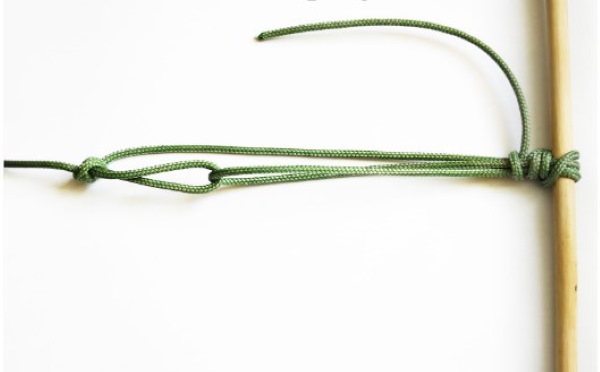
Improved rope tension
One side of the lanyard is attached to the support in a rigid way, on a hook, dowel or anchor. On the other hand, tie the rope with a self-tightening knot or loop. To increase tension, the lanyard is rotated around its axis. If you twist the device in the other direction, the rope weakens.
Another option for keeping the cable taut is to use a block roller. One end of the cable is firmly attached to the support, and the other is passed through the block. A weight is tied to the roller, which serves as a counterweight and does not allow the rope to sag.
The science of nausistics deals with the study of nodes with different purposes. And in the 21st century. specialists are improving their tying schemes, clarifying their names, and coming up with new tourist, mountaineering, and speleological ties.
Article design: Natalie Podolskaya
Where is the knot used?
The main use of a knot is to effectively connect two ropes that have a marked difference in diameter or stiffness. Its main purpose is to create additional strength when tying two ropes.
As mentioned above, this knot was and is often used in our time on ships and sailing ships to secure cables and ropes, as well as in rigging work. To be more precise, the mainsheet knot is involved in the field of tying and connecting sails and cables.
In addition, its use can also be found in mountaineering, for example, to create additional insurance when it is necessary to replace a thin rope with a thicker and stronger one, as well as for tying two ropes.
We cannot say with certainty that it will be useful in fishing or hunting directly, but why not remember it under any other conditions. In any case, this node is also a tourist one and will be useful to you in a survival situation in the forest or on a pond.


